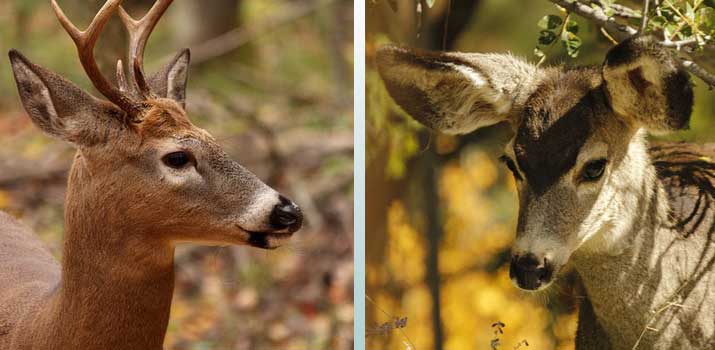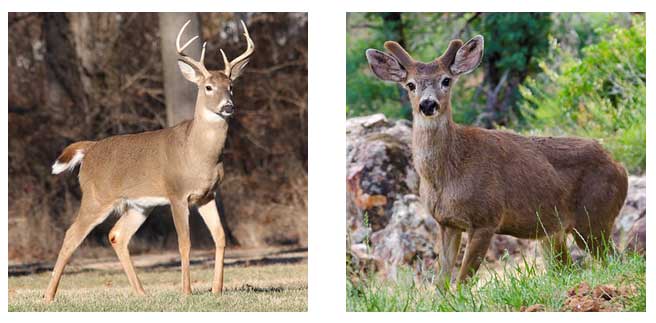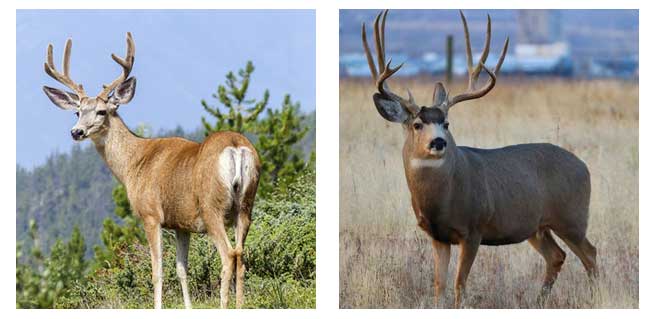A common mistake made by novice hunters and animal enthusiasts alike, is misidentifying species of deer, especially whitetail and mules.

Now, don’t be too disheartened if you too find it quite difficult to differentiate between the two – they are similar in many different ways.
But despite their general similarities in appearances, behavioral traits, and habitats, these animals are very different upon closer inspection.
Of course, if you are hunting deer, getting up close and personal is not always a privilege you can afford. Get too close and you’ll likely spook them.
So, how do you notice the difference between the two species of deer, particularly in areas where both animals are present?
Well, there are a variety of distinguishing features, that once aware of, are fairly easy to spot.
Want to learn more about the differences between whitetail and mule deer? Well, then keep on reading! Let’s find out together.
Differing Physical Characteristics Between Whitetails and Mules

Body Size
Okay, so first of all, it’s worth noting that whitetails body size can differ quite significantly depending on where they live.
For example there are Southern Texas deer that are fairly petite while Saskatchewan bucks can grow to a whopping 300 pounds.
It has become apparent that when the species lives in northern latitudes they tend to grow much larger than their southern neighbours.
This phenomenon is known as the Bergmann’s principle. However, this does not apply to the mule deer which generally all grow to around the same size.
You will usually be able to distinguish a whitetail from a mule though by their stature. A mature Illinois buck will weigh around the 200 pound mark whereas a mule will be relatively larger at around 250 pounds.
Color
Another way to tell a mule and a whitetail apart is by their color. Once matured, both species will have slightly varying color patterns.
During the summer, you can expect both animals to have a reddish-brown coat, however during the winter as their coats grow slightly longer you’ll see a more noticeable difference.
A whitetail’s longer coat tends to become a more tan hue while mules often have greyer coats.
Antler Size

The antlers of mule and whitetail deers are also pretty different. And the reason why is super interesting – it’s all to do with evolution.
You see, mules, generally speaking, live in much more open spaces than that of whitetails. And because of this, mules evolved to have much larger antlers.
Why? So that they could be used as a sexual display ornament to attract does. It’s actually pretty similar to a male lion’s luscious mane.
Contrastingly, whitetails often live in thicker forestry where visibility is limited.
This makes the need for show-stopping huge antlers pretty unnecessary as long-range attraction often isn’t in the equation for them.
Antler Shape
The shape of the antlers for these two species also differ. Whitetails tend to have single tines that sprout for the main antlers.
At maturity, they will usually have around four to five points including the ‘eye guard’ or brow tine that is visible on either side.
Mule deer, however, have ‘bifurcated’ antlers. The tines of these antlers will fork above their main antlers.
The typical mule won’t have quite as many points as a whitetail either. At maturity you can expect a mule to have between two and four spikes as well as a brow tine on either side.
However, it’s important to keep in mind that antlers can differ from animal to animal let alone species to species.
So, they won’t always look exactly the same across either species.
Ear Size
Mules usually have larger ears than that of a whitetail. Fact of the day – the species actually gets their name because of their large ears that look similar to that to a mule.
Apparently, the reason for this evolutionary trait is that the larger ear size helps them dissipate body heat in hotter habitats.
When mule deer live in colder climates, you’ll actually often find them missing chunks of their ears because they have been lost to frostbite.
It is also likely that their large ears also aid better hearing. Which comes in handy when you have to watch out for as many predators as deer do.
Tails
Any deer lover or hunter has probably seen one of the iconic photographs of a bounding buck running with their tail high to the sky, showing off their snow-white fluffy tails.
As you may have guessed by the name of the species, this is a distinguishing feature of the whitetail deer. A mule will not have the same bright white tail.
People have varying theories as to why whitetails have this feature. Some theorize that it acts as a warning to nearby deer whereas others believe it to be a predator distraction.
There’s even a notion that this could be so that young fawns can clearly spot and follow their mother when fleeing from danger.
Whatever the reason, though, it acts as a great identifying feature for us humans.
Fawns
To see a fawn is to fall in love at first sight. These young baby deer are so captivatingly beautiful.
And in the first few months of life, differentiating between a mule and whitetail is near enough impossible.
However, after a couple of months when the faws begin to lose their spots, the difference becomes much more noticeable.
As they grow older, the whitetail fawn will start to grow that fluffy white tail. The two youngsters also have slightly different movements that can help you notice the difference.
Habitat
A whitetail often travels very little. In fact, their whole lives can easily take place in no more than a single square mile.
Whitetail deer tend to stick to their birthplace and don’t venture much further out than a couple miles – and that’s at a push.
This probably has a lot to do with their habitat – everything they ever need is usually within that small distance.
For mules though, it’s a whole other story. Because of their rocky habitat, mules will often spend the summer in high elevation alpines where they have access to better food resources.
However, the winters make this habitat much less hospitable and so they must migrate to lower plains and river valleys where there are more resources and better living conditions.
Final Thoughts
Though these two species may seem very similar at a quick glance, once you start to truly observe them, they share very little in common.
Honestly, I could continue for hours about their differences in environments, their behaviours, and conservation and management challenges too.
But, for today, we’ve stuck to the basics. Their habitat and their physical appearances.
Now, you should be able to spot the differences between these two species like a real pro!
